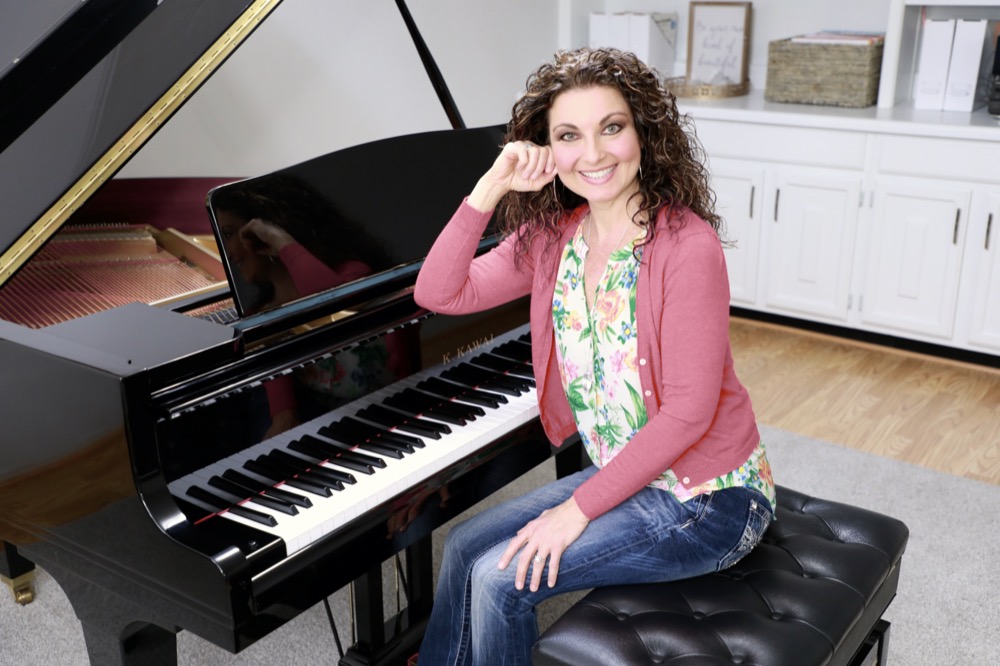The Piano Teacher’s Guide to Teaching Problem Solving in Piano Lessons
This post may contain affiliate links. If you purchase something through an affiliate link, I will receive a small commission at no cost to you. For more information, read the disclosure statement here.

I absolutely love those magical moments when my piano students discover they can solve their own practice challenges!
Teaching problem solving in piano lessons might take extra lesson time initially (actually, it definitely takes extra lesson time at first), but the long-term benefits truly change how students approach practicing their music.
Let’s explore research-backed strategies and effective ways to communicate with parents about why we’re teaching problem solving in piano lessons.
The Power of Teaching Problem Solving in Piano Lessons
Music teaching research reveals something interesting about problem solving in piano Lessons – many students feel uncertain when trying to solve practice challenges on their own.
This is completely understandable, because they generally won’t know what to do until we teach them specific ways to problem-solve.
Here’s the exciting part: When we invest time teaching problem solving in piano lessons, students develop remarkable independence in their practice sessions (Moore, 2012).
What really works, and how can we foster that independence?
The answer is by actually teaching our students the skills to do their own problem-solving in their daily practice sessions.
Let’s look at some practical problem-solving strategies you can start teaching your students right away.

1. Teach Students That They Can Follow A Problem-Solving Process
Students may not even realize they can use a process to help them locate practice challenges and solve their own practice problems, and they certainly may not know where to begin.
So our job is to teach them two things:
- That they are capable of problem-solving on their own when they are practicing at home
- That it’s as easy as asking a few specific questions to help them locate and work through challenges when they are practicing
Here are a few basic yes/no questions students can begin to ask themselves to figure out areas that need more work:
- “Did I play the correct notes?”
- Then follow-up with “Which notes need special attention?”
- “Are there any tricky rhythms?”
- Followed by “Where are they?”
- “Did I follow the articulation markings?”
- Then ask, “Which markings did I miss?”
- “Am I playing expressively with dynamics?”
- Then ask, “Where do I need to follow the dynamics more closely?”
My students keep a simple sticky note checklist of these 4 items on each of their pieces. This really helps them remember to ask the yes/no questions.
- Notes
- Rhythm
- Dynamics
- Articulation
Asking these questions regularly will help our students start forming the foundation to become skilled problem-solvers.
2. Help Students Develop Their Problem-Solving Skills
Once students have their list of items in #1 above (notes, rhythm, dynamics, articulation), and they are becoming accustomed to locating areas that need more practice, it’s time to work on their problem-solving skills.
Help them develop the ability to problem-solve by having them ask deeper questions:
- “What did I hear when I played that passage/section/segment/measure?”
- Students may answer like this, and they may need a bit of guidance on how to listen to their playing: “It sounded sloppy, there were hesitations, I keep missing this note, I’m slowing down too much, my rhythm was wrong, I didn’t hear any dynamics, I forgot the key signature, etc.”
It may take a few weeks for students to learn to listen to their playing so they can answer the questions, but that’s OK! This is a process, and students should spend as much time on each step as they need.
After students learn to listen to their playing and can answer the question above (“What did I hear?”), they are ready for the next question in the problem-solving process: Determining WHY the issue happened.
- “Why did that happen?”
- I was playing too fast, I need a fingering adjustment, I missed the key signature, I wasn’t counting, I didn’t notice the dynamics, I didn’t see the staccato, I forgot that D Major has 2 sharps, etc.
They may not know why it happened at first, but we can teach them to think about it and help them understand why.
The more we help them think about what happened and why, the better-equipped they will be for the last question in the problem-solving process, which is extremely important:
- “How can I make it better?”
- Slow down, write a finger number, highlight or circle the sharp or flat, count out loud, drill this measure, exaggerate the dynamics more, make my staccatos shorter, play my scales more cleanly, etc.
This is where we want our students to be: At a place where they can easily determine where they are struggling, why, and what to do about it.

Making Problem Solving A Natural Part of Piano Study
Teaching problem solving in piano lessons will eventually become a normal part of weekly lessons and practice sessions.
You’re going to love how these problem-solving techniques boost your students’ at-home practice sessions!
Here’s how I implement problem-solving strategies on a weekly basis in lessons so they become a seamless part of what we do.
1. Dedicate Practice Time in Lessons
- Model effective problem-solving approaches
- Ask lots of leading questions to help them internalize the problem-solving process
- Have students demonstrate their own problem-solving strategies
- Provide gentle guidance and encouragement
- Celebrate their problem-solving successes
2. Create a Supportive Environment
Studies show that elementary-aged students develop stronger practice habits when they feel confident about solving practice problems (Donnelley, 2001). Make your lessons a safe space for students to:
- Experiment with different solutions
- Share their thinking process
- Learn from mistakes
- Build confidence gradually
Red Flags: When Students Need Help with Problem-Solving Skills
As piano teachers, we need to watch for signs that students are struggling with practice problem solving. Here are key indicators that a student needs additional support:
- Playing through mistakes repeatedly without stopping
- Always starting from the beginning of the piece, even when working on a specific section (marking their place with sticky notes will help)
- Getting frustrated and giving up quickly when encountering challenges
- Inability to identify where problems are occurring in their playing
- Using the same ineffective strategy repeatedly, hoping for different results

Working with Parents: Supporting Problem Solving at Home
Communicating with Parents about Problem-Solving Practice
Here’s effective language to use when explaining practice problem solving to parents:
“When we focus on problem-solving skills during practice, we’re teaching students to:
- Think critically about their playing
- Develop independence at the piano
- Build confidence in their abilities
- Create lifelong learning habits
- Make their practice time efficient and effective”
Parent Checklist for Supporting Problem-Solving Practice
Share these simple guidelines with parents:
- Listen for your child stopping to work on specific spots
- Encourage them when they take time to solve problems
- Ask what they’re working on specifically today
- Celebrate when they figure something out
- Allow time for working through challenges
Addressing Common Parent Concerns
“But shouldn’t they just play through their pieces?”
Response: “While playing through pieces is important, problem-solving practice helps students progress faster and develop deeper understanding.”
“This seems to take longer than regular practice…”
Response: “Initially it might take more time, but these skills lead to more efficient practice and faster progress in the long run.”
“My child gets frustrated when they can’t play it right away…”
Response: “Learning to work through challenges builds resilience and confidence. We can help by celebrating their problem-solving efforts.”
Seeing Long-Term Results
When we invest time in teaching problem solving in piano lessons, we give our students tools they can use throughout their lives.
Research shows that students who develop strong problem-solving skills:
- Progress more steadily
- Feel more confident about their playing
- Enjoy their practice time more
- Become more independent musicians
Incorporating teaching problem solving in piano lessons might take up to half of your lesson time initially, but this investment pays off beautifully as students develop independence and confidence in their practice sessions.
What’s your favorite tip for teaching problem-solving in piano practice? Share your experiences in the comments below!
References
Breth, N. O. (2001). The piano student’s guide to effective practicing. Arlington, VA.
Donnelley, M. (2001). Problem-solving behavior in children’s piano practice [Doctoral dissertation, University of Illinois at Urbana-Champaign].
Mauro, L., & Beard, S. (2001). Helping students get more out of practicing. American Music Teacher, 50(5), 24-26.
Moore, M. (Ed.). (2012). Critical Essays in Music Education (1st ed.). Routledge.
Pace, R. (1999). Improvisation and creative problem-solving. In The Essentials of Keyboard Pedagogy. Chatham, NY: Lee Roberts Music Publications, Inc.
Don't miss out!
Follow on Facebook and Instagram, join the best Facebook group for piano teachers, and subscribe to the newsletter to get helpful teaching tips, resources, and tutorials delivered straight to your inbox every week.
Melody Payne
Melody Payne
Welcome!

Hi! I’m Melody Payne, a pianist and piano teacher, educational resource author, a fun-loving wife to the most wonderful and talented hubby I could ask for, and a lifelong learner who loves to share. I want to make your life as a music teacher easier by writing and sharing helpful and relevant music teaching articles, and by creating educational resources with your very own students in mind. If you are a parent who wants to enroll your child in piano lessons, I’d love for us to get started building those skills that can give your child a lifetime of musical enjoyment!

